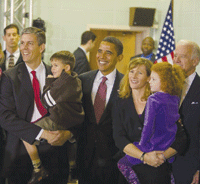Between classes at Fenger High School, on the far south side of Chicago, hundreds of students churn through the halls. Elizabeth Dozier, the new principal, keeps a watchful eye. She wears a two-way radio to deal with problems the minute they arise. One is small: the girls’ toilets have no paper towels. One is bigger: there’s a brawl upstairs. It’s not to be ignored: on September 24 an honour-roll student was beaten to death near Fenger, swept up in senseless violence.
 For an idea of the task confronting Arne Duncan, President Barack Obama’s education secretary, Fenger is a good place to start. From 2006 to 2008, fewer than 3 percent of pupils met Illinois’s meagre standards of achievement. But this year everything is supposed to change. The Chicago school district chose Fenger as a ‘turnaround’. Old teachers have been sacked and new programmes put in place. Fenger faces formidable odds. But if Duncan has his way, the school’s transformation will signal the start of a larger shift.
For an idea of the task confronting Arne Duncan, President Barack Obama’s education secretary, Fenger is a good place to start. From 2006 to 2008, fewer than 3 percent of pupils met Illinois’s meagre standards of achievement. But this year everything is supposed to change. The Chicago school district chose Fenger as a ‘turnaround’. Old teachers have been sacked and new programmes put in place. Fenger faces formidable odds. But if Duncan has his way, the school’s transformation will signal the start of a larger shift.
Duncan, the former chief of Chicago’s schools, finds himself in an unprecedented position. No education secretary has ever had so much money to drive reform. Thanks largely to the federal stimulus, he has more than $10 billion (Rs.46,000 crore), including $3.5 billion (Rs.16,127 crore) to turn around schools. More than $4 billion (Rs.18,435 crore) will go to states that pursue specific initiatives: final guidelines for applications will be issued this autumn, and states are scurrying to prepare. Duncan calls the money a “moon shot” — for his department and for the country.
There is appetite for reform. Almost three-quarters of Americans think that the problems facing education are at least as grave as those facing healthcare, according to a poll conducted for The Economist by YouGov. George Bush’s education law, No Child Left Behind (NCLB), attempted to set standards and hold schools accountable for meeting them. But 61 percent think that NCLB has had no effect or has actually hurt America’s schools. The act is overdue for reauthorisation, and on September 24 Duncan described possible changes to it. In the meantime, however, he and Obama are using stimulus cash to pursue goals of their own.
The education department has divided the cash into several programmes, including a $650 million (Rs.2,998 crore) ‘Investing in Innovation’ fund that will award grants not only to school districts but to private groups that run schools. The biggest pot of money is the $4.4 billion (Rs.20,286 crore) Race to the Top, which will reward states for reform in four areas. First, it will support internationally benchmarked standards and tests, an effort to reverse the tendency of states to weaken standards under NCLB. Second, Race to the Top will streamline the collection of pupil data and use it to improve teaching. Third, the fund will encourage states to use performance to determine training and, controversially, pay and promotion. Fourth, the fund will support efforts to help struggling schools. A state may not apply if it forbids the use of pupil data to evaluate teachers. States will be at a disadvantage if they place limits on charter schools, publicly funded schools that operate without traditional regulations.
Even more ambitious, Duncan is directing $3.5 billion (Rs.16,127 crore) to turn around the country’s 5,000 worst schools within five years. NCLB was supposed to help bad schools improve, but most states pursued superficial reform. Now Duncan is offering four stringent options: replace the principal and at least half the staff; reopen the school under the management of a private group; close the school and enroll students elsewhere; or make sweeping changes such as extending the school day and giving principals more autonomy.
Most daunting, however, is the task of turning around failing schools. It may be difficult to find sufficient manpower to do this. Charter groups usually prefer to start new schools, rather than improve existing ones burdened by bad habits and union rules. Talented teachers are hard to recruit and keep. And despite some success stories, there is still debate on which changes work. In most places, including Duncan’s Chicago, results are mixed or reforms are too new to judge their success, explains Tim Knowles, director of the Urban Education Institute at the University of Chicago.
(Excerpted and adapted from The Economist)